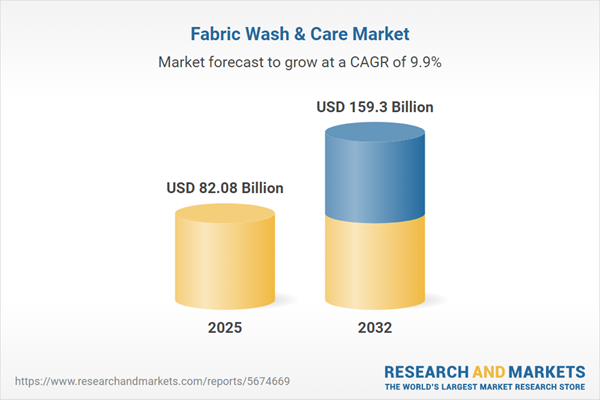Speak directly to the analyst to clarify any post sales queries you may have.
The fabric wash and care market is evolving rapidly amid sustainability imperatives, digital transformation, and shifting consumer expectations. Senior decision-makers must stay agile as environmental, regulatory, and technology trends shape strategies and competitive positioning in this global sector.
Market Snapshot: Fabric Wash & Care Growth Outlook
The Fabric Wash & Care Market grew from USD 74.79 billion in 2024 to USD 82.08 billion in 2025. With a projected CAGR of 9.91%, the sector is expected to reach USD 159.30 billion by 2032.
Key factors behind this expansion include rising consumer focus on eco-friendly ingredients, increased demand for advanced laundry solutions, and accelerated digital retail adoption. Tariff impacts and supply chain agility are further defining the competitive landscape for global manufacturers and suppliers.Scope & Segmentation: Comprehensive View of Fabric Wash & Care
- Product Types: Fabric softeners; laundry bars and powders; laundry detergents; specialty cleaners.
- Form Factors: Liquid (refillable containers, single-use sachets); powder (loose packs, sachets); tablet/pod (multi-compartment pods, single-dose pods).
- End Users: Commercial (healthcare, hospitality, industrial laundry services); residential (urban and rural households).
- Distribution Channels: Convenience stores; online retail (brand websites, social commerce, third-party platforms); specialty stores (multi-brand, single-brand outlets); supermarkets and hypermarkets.
- Key Ingredients: Enzymatic (amylase, cellulase, lipase, protease); non-enzymatic (solvent-based, surfactant-based).
- Packaging Types: Bottles (HDPE, PET); boxes (carton, recyclable); pouches (spouted, stand-up).
- Regional Analysis: Americas (North America – United States, Canada, Mexico; Latin America – Brazil, Argentina, Chile, Colombia, Peru); Europe, Middle East & Africa (Europe – United Kingdom, Germany, France, Russia, Italy, Spain, Netherlands, Sweden, Poland, Switzerland; Middle East – United Arab Emirates, Saudi Arabia, Qatar, Turkey, Israel; Africa – South Africa, Nigeria, Egypt, Kenya); Asia-Pacific (China, India, Japan, Australia, South Korea, Indonesia, Thailand, Malaysia, Singapore, Taiwan).
- Company Profiles: The Procter & Gamble Company, Unilever PLC, Henkel AG & Co. KGaA, Reckitt Benckiser Group PLC, Church & Dwight Co., Inc., Colgate-Palmolive Company, Kao Corporation, The Clorox Company, Shanghai Jahwa United Co., Ltd., and Lion Corporation.
Key Takeaways for Decision-Makers
- Sustainability is central to fabric wash and care innovation, with brands investing in eco-friendly formulas and packaging to address both consumer demand and evolving regulations.
- Digitalization is transforming traditional retail, with omnichannel strategies and direct-to-consumer platforms helping companies reach and engage varied customer segments more effectively.
- Manufacturers are optimizing ingredient portfolios, balancing efficacy with factors like skin sensitivity and environmental credentials, often leveraging novel enzyme and plant-based solutions.
- Operational agility is becoming critical due to shifting labor, logistics costs, and regulatory requirements, prompting investment in local production, agile supply chains, and data-driven logistics management.
- Segmented product offerings address diverse needs, from tailored commercial solutions in healthcare and hospitality to multi-function products favored by urban and rural consumers.
- Strategic collaborations—between global, regional, and local players—are advancing technology adoption and expanding brand reach, supported by innovative packaging and circular economy initiatives.
Tariff Impact: Supply Chain Resilience and Market Accessibility
US tariffs enacted in 2025 introduced added complexity, particularly for imported raw materials and finished goods. Manufacturers responded with diversified supplier bases, regional sourcing initiatives, and collaborative ventures designed to mitigate cost fluctuations. Distribution networks have adapted procurement strategies and contract terms, fostering greater supply chain resilience and supporting the development of localized manufacturing capacity.
Methodology & Data Sources
This analysis utilizes a multi-tiered approach, incorporating secondary research from white papers and regulatory filings, executive interviews, and quantitative surveys across end-user segments. Triangulation, statistical validation, and scenario analysis underpin the reliability of insights presented in this report.
Why This Report Matters: Actionable Value for Senior Leaders
- Equips decision-makers with strategic intelligence to anticipate regulatory and consumer-driven shifts in the fabric wash and care landscape.
- Supports operational planning and sourcing optimization with a deep dive into tariff impacts and supply chain dynamics.
- Reveals technology, segmentation, and regional trends—enabling leaders to pursue new revenue streams and build competitive advantages through innovation and collaboration.
Conclusion
The fabric wash and care market is in a period of dynamic change, guided by sustainability, digital engagement, and regulatory pressure. Stakeholders who prioritize agility and informed innovation will be well-positioned for sustained success in this evolving industry.
Additional Product Information:
- Purchase of this report includes 1 year online access with quarterly updates.
- This report can be updated on request. Please contact our Customer Experience team using the Ask a Question widget on our website.
Table of Contents
3. Executive Summary
4. Market Overview
7. Cumulative Impact of Artificial Intelligence 2025
Companies Mentioned
The companies profiled in this Fabric Wash & Care market report include:- The Procter & Gamble Company
- Unilever PLC
- Henkel AG & Co. KGaA
- Reckitt Benckiser Group PLC
- Church & Dwight Co., Inc.
- Colgate-Palmolive Company
- Kao Corporation
- The Clorox Company
- Shanghai Jahwa United Co., Ltd.
- Lion Corporation
Table Information
| Report Attribute | Details |
|---|---|
| No. of Pages | 191 |
| Published | October 2025 |
| Forecast Period | 2025 - 2032 |
| Estimated Market Value ( USD | $ 82.08 Billion |
| Forecasted Market Value ( USD | $ 159.3 Billion |
| Compound Annual Growth Rate | 9.9% |
| Regions Covered | Global |
| No. of Companies Mentioned | 11 |









